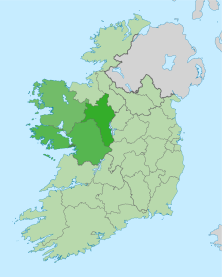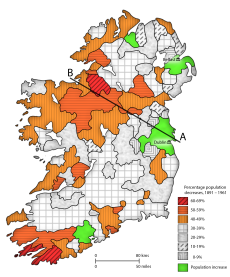👉 Find out about The Open University's Geography courses. 👈
Explore the articles in this collection
-
Change in the West of Ireland
Read now to access more details of Change in the West of IrelandIntroducing a collection of articles asking 'How can unique and distinctive regions, like the West of Ireland, retain the qualities that make them unique while continuing to modernise and interact with the wider world?'

Article
-
Synthesis as a way of understanding the changing uniqueness of rural Ireland
Take part now to access more details of Synthesis as a way of understanding the changing uniqueness of rural IrelandWhat is synthesis? Discover how this way of thinking helps us to understand more about the way in which places retain their uniqueness within wider systems of interdependence.

Activity
-
The West of Ireland: Dimensions of distinctiveness
Read now to access more details of The West of Ireland: Dimensions of distinctivenessHow do you define 'the West of Ireland'? Do you look at cultural factors, geography, or something else?

Article
-
Culture and regional distinctiveness
Read now to access more details of Culture and regional distinctivenessCulture and how language identifies that culture are key to understanding what makes a region unique.

Article
-
The rural dimension – rundale in the West of Ireland
Read now to access more details of The rural dimension – rundale in the West of IrelandThe rundale system once governed how farmland was distributed between tenants in Ireland. It supposedly died out in the 19th century, but this was not actually the case in some parts of the West of Ireland.

Article
-
The rural dimension – after rundale
Watch now to access more details of The rural dimension – after rundaleHow did the rural areas of Western Ireland change after the rundale system was replaced?

Video
-
A changing uniqueness – The changing ‘place’ of the West
Read now to access more details of A changing uniqueness – The changing ‘place’ of the WestThe population of Western Ireland declined dramatically between 1891 and 1961. How do you think this affected Ireland as a whole?

Article
-
The realities of rural life in the 1950s-1980s
Watch now to access more details of The realities of rural life in the 1950s-1980sThe period of the 1950s to 1980s was the beginning of modernisation in community life and farming and the development of manufacturing industry in the West of Ireland.

Video
-
Culture and the manufacturing industry, 1983
Watch now to access more details of Culture and the manufacturing industry, 1983In 1983, the fight to retain a unique Irish speaking culture meant that jobs had to be created locally in manufacturing and tourism so that Irish speakers no longer had to emigrate, but industrialisation also threatened the survival of the Irish language.

Video
-
A new layer: Culture, the Irish language and identity in 2015
Watch now to access more details of A new layer: Culture, the Irish language and identity in 2015We revisit the Glencolmcille folk village in 2015 to see whether the dilemma of development and the local language and culture has been resolved.

Video
-
Southwest Donegal: uniqueness and interdependence in 2015
Read now to access more details of Southwest Donegal: uniqueness and interdependence in 2015In Southwest Donegal, we see both the local uniqueness and different interdependencies and interconnections with other places.

Article
-
The future of rural Ireland - nuances, scale and fighting back
Read now to access more details of The future of rural Ireland - nuances, scale and fighting backThe future of rural Ireland - nuances, scale and fighting back

Article
Transcript: Tourism, crafts and the Irish language?
PAT JESS
Tourism has recently developed as an important aspect of the local economy. Some of the areas characteristics like its remoteness and its traditional culture are precisely what makes it attractive to increasing numbers of visitors. This has brought back an interest in local crafts. The handlooms are back in use to produce wall hangings and other craft items.
Developments like the holiday village in Glencolmcille were boosted by the initiative of Father McDyer. But what effect has increased tourism had on the local culture and language?
Tourism was developing as an important aspect of the economy in 1983. An interest in local crafts and handlooms had led to the establishment of Studio Donegal. In Glencolmcille, the holiday village and folk museum, built with local community effort, had opened in 1967. However, Father McDyer summed up the dilemma:
“Now of course it’s a catch 22 question, are you going to lead this into a sort of Indian reservation and have no development at all or are you going to risk the language and the culture by having development?”
Transcript: Father McDyer, 1983: 'The dilemma of development'
FATHER MCDYER
Tourism is particularly obnoxious in obliterating local traditional culture, because tourists come from afar, whether it’s from this country or other countries, and naturally people in an isolated place like this are inclined to ape the tourists in their way of life and in their value and particularly in their mode of speech.
The girls here in charge of our Folk Museum if they meet tourists, as they do, they have to converse in English. So very gradually the Irish spoken residue that we have here is becoming eroded through the development of tourists. Now of course it’s a catch 22 question: are you going to leave this into a sort of an Indian reservation and have no development at all or are you going to risk the language or the culture by having development?
I came down heavily on the side of the latter because I claimed that if you didn’t have development you would soon have no people here at all. But I do think having got a certain amount of development going industrial-wise and tourist-wise then you’ve got to work twice as hard then to try to restore the values that have been lost and especially the language that has been lost.
In 1983, positive action was being taken to restore the Irish language and traditions such as described by Michael O'Donnell, ex-shop steward in the Kilcar factory. He was Chairman of the local parish council and active in promoting the Irish culture and language as part of the making of a new synthesis of economy and culture. But this would not be easy. The place of the Irish language as a living part of the synthesis was still to be determined.
Transcript: Michael O'Donnell, 1983: 'The future of the Irish language?'
PRESENTER
The Kilcar community is working hard to restore the Irish language and traditions. Michael O’ Donnell who is shop steward in the Kilcar factory is now leader of the parish council. What is it doing about restoring the language?
MICHAEL O’ DONNELL
Well we attack that on many fronts. First we set up a cultural organisation in the parish which would look after all the aspects and the cultural line. For instance take the language now. We did see that of course the language as the life of Ireland, that is the heart of Ireland in a way, and for that reason we had to do something about a language that appeared to be slipping a bit over the last few years.
PRESENTER
However much the Irish language might be slipping the area itself has been revitalised. Emigration has been stemmed and the local population is increasing for the first time in living memory. The new synthesis of economy and culture’s in the making. There are formidable problems on both fronts, whether the Irish language remains a living part of this synthesis, only time will tell.
[Gaelic singing]
We are looking at a local area which is unique - yet many of the characteristics which we've seen can be found elsewhere. What makes Southwest Donegal unique is not the characteristics themselves, but the specific combination of those characteristics.
- Can you identify some of these combinations?
- What combinations of characteristics can you identify for your own home place?
Explore the articles in this collection
-
Change in the West of Ireland
Read now to access more details of Change in the West of IrelandIntroducing a collection of articles asking 'How can unique and distinctive regions, like the West of Ireland, retain the qualities that make them unique while continuing to modernise and interact with the wider world?'

Article
-
Synthesis as a way of understanding the changing uniqueness of rural Ireland
Take part now to access more details of Synthesis as a way of understanding the changing uniqueness of rural IrelandWhat is synthesis? Discover how this way of thinking helps us to understand more about the way in which places retain their uniqueness within wider systems of interdependence.

Activity
-
The West of Ireland: Dimensions of distinctiveness
Read now to access more details of The West of Ireland: Dimensions of distinctivenessHow do you define 'the West of Ireland'? Do you look at cultural factors, geography, or something else?

Article
-
Culture and regional distinctiveness
Read now to access more details of Culture and regional distinctivenessCulture and how language identifies that culture are key to understanding what makes a region unique.

Article
-
The rural dimension – rundale in the West of Ireland
Read now to access more details of The rural dimension – rundale in the West of IrelandThe rundale system once governed how farmland was distributed between tenants in Ireland. It supposedly died out in the 19th century, but this was not actually the case in some parts of the West of Ireland.

Article
-
The rural dimension – after rundale
Watch now to access more details of The rural dimension – after rundaleHow did the rural areas of Western Ireland change after the rundale system was replaced?

Video
-
A changing uniqueness – The changing ‘place’ of the West
Read now to access more details of A changing uniqueness – The changing ‘place’ of the WestThe population of Western Ireland declined dramatically between 1891 and 1961. How do you think this affected Ireland as a whole?

Article
-
The realities of rural life in the 1950s-1980s
Watch now to access more details of The realities of rural life in the 1950s-1980sThe period of the 1950s to 1980s was the beginning of modernisation in community life and farming and the development of manufacturing industry in the West of Ireland.

Video
-
Culture and the manufacturing industry, 1983
Watch now to access more details of Culture and the manufacturing industry, 1983In 1983, the fight to retain a unique Irish speaking culture meant that jobs had to be created locally in manufacturing and tourism so that Irish speakers no longer had to emigrate, but industrialisation also threatened the survival of the Irish language.

Video
-
A new layer: Culture, the Irish language and identity in 2015
Watch now to access more details of A new layer: Culture, the Irish language and identity in 2015We revisit the Glencolmcille folk village in 2015 to see whether the dilemma of development and the local language and culture has been resolved.

Video
-
Southwest Donegal: uniqueness and interdependence in 2015
Read now to access more details of Southwest Donegal: uniqueness and interdependence in 2015In Southwest Donegal, we see both the local uniqueness and different interdependencies and interconnections with other places.

Article
-
The future of rural Ireland - nuances, scale and fighting back
Read now to access more details of The future of rural Ireland - nuances, scale and fighting backThe future of rural Ireland - nuances, scale and fighting back

Article
Rate and Review
Rate this video
Review this video
Log into OpenLearn to leave reviews and join in the conversation.
Video reviews